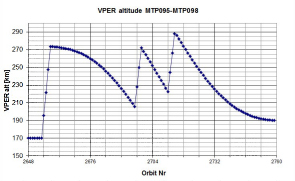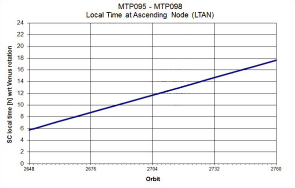No. 266 - Continuation of quadrature operations, temporary star tracker outage, start of the sixteenth occultation season, and entire thirteenth Atmospheric Drag Experiment Campaign
Cebreros ground station
All Cebreros ground station activities were nominal during this reporting period.
As planned, Cebreros communication passes on 14, 16, 18, 21 and 23 October were skipped to allow sufficient time for the spacecraft to cool between Earth pointings during the quadrature operations.
New Norcia ground station
The Intermediate Frequency and Modem System 1 (IFMS1) of the New Norcia ground station experienced issues with locking [with the spacecraft] during occultation observations since the beginning of the occultation season on 16 October, until 28 October. This problem was investigated by ESTRACK but the underlying reason was not found; the problem did not recur again during this reporting period. While the anomaly was under investigation, NASA Deep Space Network support was requested during occultation ingress and egress, which is when the anomaly is seen to occur.
Problems with the ground station configuration affected the occultation passes on 8 November.
High-accuracy spacecraft ranging
ESA's Cebreros and New Norcia ground stations were used for a Delta Differential One-way Ranging (delta-DOR, or DDOR) measurement at the start of the Cebreros communications pass on 17 October.
These high accuracy ranging measurements are carried out with the Venus Express spacecraft on a regular basis to support the accurate determination of the ephemeris for the planet Venus that is maintained by NASA's Solar System Dynamics Group.
For more information about DDOR, see "Delta-DOR measurements".
Continuation of quadrature operations
The spacecraft continued to operate in the quadrature configuration during this reporting period.
As per routine quadrature operations procedures, the secondary High Gain Antenna, HGA-2, was swapped with the primary, HGA-1, on 29 October to temporarily become the primary means of communication. This occurred while the spacecraft was outside visibility and hence safing commands were uploaded simultaneously. The swap proceeded smoothly and the safing commands were later deleted during the communications pass on the same day. The illumination conditions during quadrature make Earth pointings 'hot' during communications periods with Earth. The spacecraft was kept in the cool orientation for a few hours to recover from these hot pointings, allowing no solar illumination on thermally sensitive faces, and Earth communication passes were skipped every second day during this quadrature season. The telemetry rate was lowered to 38 kbps after the swap.
For more information on quadrature operations see 'Quadrature operations on Venus Express'.
Start of the sixteenth occultation season
The sixteenth occultation season started on 25 October and continued throughout this reporting period.
The first occultation of the season, on 25 October, was a tangential occultation: the spacecraft did not actually pass behind Venus from the point of view of the ground station. Thus the start and end times for the first occultation observation were not recorded in the relevant file at first. The file was later modified to reflect the change due to the tangential occultation.
For more information, see 'Venus Express Earth occultation seasons'.
Temporary star tracker outage
The spacecraft's star tracker experienced an outage from 18:12 UTC to 22:31 UTC on 28 October. An analysis of spacecraft data was carried out, which ruled out outages due to nominal blinding. Earth-orbiting satellites detected an X1-class solar flare on 28 October at 02:03 UTC and the GOES satellite also showed a proton flux increase at the time of the anomaly. Thus it was determined that the cause of the outage was increased solar activity.
The star tracker has experienced no problems since and is operating nominally.
The thirteenth Atmospheric Drag Experiment campaign
The thirteen Atmospheric Drag Experiment (ADE) Campaign started on 30 October, and ended on 9 November, the last day of this reporting period.
Read more about ADE campaigns here.
Summary of main activities
The table below shows a chronology of the main spacecraft bus activities in the reporting period:
| Main activities during reporting period | |||
| ADE = Atmospheric Drag Experiment; CEB = Cebreros; DDOR = Delta Differential One-way Ranging; DOY = Day of year; MET = Mission elapsed time; NNO = New Norcia; TM = telemetry | |||
|
MET (Day) |
Date | DOY | Main Activity |
| 2896 | 13-Oct-2013 | 286 | CEB communication pass. |
| 2897 | 14-Oct-2013 | 287 | CEB skipped pass. |
| 2898 | 15-Oct-2013 | 288 | CEB communication pass. |
| 2899 | 16-Oct-2013 | 289 | CEB skipped pass. |
| 2900 | 17-Oct-2013 | 290 | CEB communication pass; DDOR with NNO and CEB. |
| 2901 | 18-Oct-2013 | 291 | CEB skipped pass. |
| 2902 | 19-Oct-2013 | 292 | CEB communication pass. |
| 2903 | 20-Oct-2013 | 293 | CEB communication pass. |
| 2904 | 21-Oct-2013 | 294 | CEB skipped pass. |
| 2905 | 22-Oct-2013 | 295 | CEB communication pass. |
| 2906 | 23-Oct-2013 | 296 | CEB skipped pass; NNO radio science pass. |
| 2907 | 24-Oct-2013 | 297 | CEB communication pass; problem with primary CEB telemetry chain, VIRTIS and MAG data lost. |
| 2908 | 25-Oct-2013 | 298 | Start of the sixteenth occultation season; NNO radio science pass; CEB communication pass. |
| 2909 | 26-Oct-2013 | 299 | CEB communication pass. |
| 2910 | 27-Oct-2013 | 300 | NNO radio science pass; CEB communication pass. |
| 2911 | 28-Oct-2013 | 301 | NNO radio science pass; CEB communication pass; Retrieval of VIRTIS and MAG data that were missed due to a problem with the primary TM chain at CEB on 24 October. |
| 2912 | 29-Oct-2013 | 302 | NNO radio science pass; CEB communication pass; HGA-1 to HGA-2 swap as part of the inbound quadrature operations, Telemetry bit rate change from 228 kbps to 38 kbps. |
| 2913 | 30-Oct-2013 | 303 | NNO radio science pass; CEB communication pass; start of the thirteenth ADE campaign. |
| 2914 | 31-Oct-2013 | 304 | NNO radio science pass; CEB communication pass. |
| 2915 | 1-Nov-2013 | 305 | NNO radio science pass; CEB communication pass. |
| 2916 | 2-Nov-2013 | 306 | NNO radio science pass; CEB communication pass. |
| 2917 | 3-Nov-2013 | 307 | NNO radio science pass; CEB communication pass. |
| 2918 | 4-Nov-2013 | 308 | NNO radio science pass; CEB communication pass. |
| 2919 | 5-Nov-2013 | 309 | NNO radio science pass; CEB maintenance followed by shortened communication pass. |
| 2920 | 6-Nov-2013 | 310 | NNO radio science pass; CEB maintenance followed by shortened communication pass. |
| 2921 | 7-Nov-2013 | 311 | NNO radio science pass; CEB communication pass. |
| 2922 | 8-Nov-2013 | 312 | NNO radio science pass – only partial data recording due to misconfiguration of station; CEB communication pass. |
| 2923 | 9-Nov-2013 | 313 | NNO radio science pass; CEB communication pass; end of the sixteenth occultation season. |
At the end of the reporting period on 9 November Venus Express was 92.2 million kilometres from Earth. The one-way signal travel time was 304 seconds. The final oxidizer mass was 15.005 kg and the final fuel mass was 9.119 kg.
Scientific focus
This reporting period falls under the ninety-eighth medium term planning period (MTP 98), which covered the period from 13 October to 9 November 2013.
Local time at ascending node (LTAN) varied from 14:40 to 17:40, thus the season was 'hot', in other words: nadir pointings would illuminate the -Z face of the spacecraft. Since quadrature continued throughout this entire reporting period, and Earth pointing for communication passes lit up a thermally sensitive face of the spacecraft, hot science observations could only be carried out if a communications pass was skipped. That allowed the spacecraft to cool down before the hot science observation was carried out.
Science priority was given to the SO2 campaign that had started in the earlier planning period MTP 95 (see status report no. 263). To facilitate this, 2 to 3 communication passes per week were skipped. This allowed the continuation of the hot nadir pointings to make the SO2 measurements. The measurements were taken on a 2 to 4 day interval until the beginning of the atmosphere drag experiment season on 29 October. These nadir measurements of SO2 obtained with the ultraviolet channel of the SPICAV spectrometer were important for co-ordination with ground-based observers - the afternoon sector of Venus was sounded by the nadir observations, which was also the side of the planet visible from Earth.
The sixteenth occultation season started on 25 October. These Earth occultations allowed the VeRa radio science instrument to pass a downlink carrier to a ground station as the signal penetrated the Venus atmosphere. This technique sounds the atmosphere and allows temperature profiles of the atmosphere to be developed.
Payload activities
| ASPERA | The instrument was regularly operated nominally as part of the routine plan. |
| MAG | The instrument was regularly operated nominally as part of the routine plan. MAG data that were lost due to a problem with the primary telemetry chain at Cebreros on 24 October were later retrieved, on 28 October. |
| PFS | This instrument was not operated. |
| SPICAV | The instrument was regularly operated nominally as part of the routine plan. |
| VMC | The instrument was regularly operated nominally as part of the routine plan. Five single image commands did not get execution verification on 17 October. This anomaly has been observed before and is under investigation. |
| VeRa | The instrument was regularly operated nominally as part of the routine plan. |
| VIRTIS | The instrument was regularly operated nominally as part of the routine plan. VIRTIS data that were lost due to a problem with the primary telemetry chain at Cebreros on 24 October were later retrieved, on 28 October. |
Future milestones
- Aerobraking High Altitude Flight test
Legal disclaimer
This report is based on four ESOC mission operations reports, MOR 411 through MOR 414, as well as the MTP98 Master Science Report. Please see the copyright section of the legal disclaimer (bottom of this page) for terms of use.






